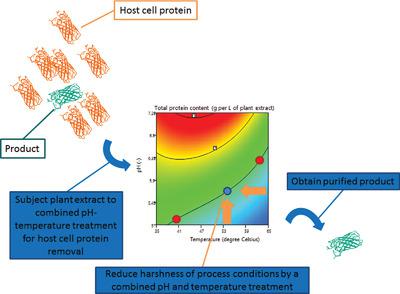当前位置:
X-MOL 学术
›
Biotechnol. J.
›
论文详情
Our official English website, www.x-mol.net, welcomes your feedback! (Note: you will need to create a separate account there.)
A combined pH and temperature precipitation step facilitates the purification of tobacco‐derived recombinant proteins that are sensitive to extremes of either parameter
Biotechnology Journal ( IF 4.7 ) Pub Date : 2020-11-28 , DOI: 10.1002/biot.202000340 Patrick Opdensteinen 1 , Aleksandr Lobanov 2 , Johannes Felix Buyel 1, 2
Biotechnology Journal ( IF 4.7 ) Pub Date : 2020-11-28 , DOI: 10.1002/biot.202000340 Patrick Opdensteinen 1 , Aleksandr Lobanov 2 , Johannes Felix Buyel 1, 2
Affiliation

|
Incubation at pH 4.0 or blanching at ∼65°C facilitates the purification of biopharmaceutical proteins from plants by precipitating most of the host cell proteins (HCPs) before chromatography. However, both methods are compatible only with pH or thermostable target proteins whereas many target proteins may irreversibly denature, e.g., at pH < 4.0. Here, we developed a combined pH/temperature treatment for clarified tobacco extracts and intact leaves. The latter were subjected to a blanching procedure, i.e., the submersion into a hot buffer. Using a design of experiments approach we identified conditions that remove ∼70% of HCPs at ∼55°C, using the thermosensitive antibody 2G12 and the pH‐sensitive DsRed as model proteins. We found that pH and temperature exerted a combined effect during the precipitation of HCPs in the pH range 5.0–7.0 at 35°C–60°C. For clarified extracts, the temperature required to achieve a DsRed purity threshold of 20% total soluble protein (TSP) increased from 54°C to 63°C when the pH was increased from 6.4 to 7.3. The pH‐stable antibody 2G12 was less responsive to the combined treatment, but the purity of 1% TSP was achieved at 35°C instead of 44°C when the pH was reduced from 6.3 to 5.8. When blanching intact leaves, product losses were not exacerbated at pH 4.0. Indeed, the highest DsRed purity (58% TSP) was achieved at this pH, combined with a temperature of 60°C and an incubation time of 30 min. In contrast, the highest 2G12 purity (0.7% TSP) was achieved at pH 5.1 and 40°C with an incubation time of 20 min. Our data suggest that a combined pH/temperature regime can avoid extreme values of either parameter; therefore, broadening the applicability of these simple purification techniques to other recombinant proteins.
中文翻译:

pH和温度沉淀相结合的步骤有助于纯化对任一参数极端敏感的烟草衍生重组蛋白
通过在层析之前沉淀大多数宿主细胞蛋白(HCP),可在pH 4.0下温育或在约65°C的温度下使溶液变白,从而促进从植物中纯化生物制药蛋白。但是,这两种方法仅与pH或热稳定的靶蛋白相容,而许多靶蛋白可能会不可逆地变性,例如在pH <4.0时。在这里,我们为净化的烟草提取物和完整的叶子开发了一种结合了pH /温度的处理方法。后者经受热烫处理,即浸入热缓冲液中。通过设计实验方法,我们确定了在约55°C下使用热敏抗体2G12和pH敏感DsRed作为模型蛋白可去除约70%的HCP的条件。我们发现,pH和温度在5.0-7范围内的HCP沉淀过程中发挥了综合作用。在35°C–60°C下为0。对于澄清的提取物,当pH从6.4升高到7.3时,达到DsRed纯度阈值的20%可溶性总蛋白(TSP)所需的温度从54°C升高到63°C。pH稳定的抗体2G12对联合处理的反应较弱,但当pH从6.3降低至5.8时,在35°C而不是44°C时达到了1%TSP的纯度。当对完整的叶子进行热烫时,在pH 4.0下产品损失不会加剧。实际上,在此pH值,60°C的温度和30分钟的孵育时间下,可获得最高的DsRed纯度(58%TSP)。相反,在pH 5.1和40°C下孵育20分钟的时间可获得最高2G12纯度(0.7%TSP)。我们的数据表明,结合使用pH /温度范围可以避免任何一个参数的极端值。所以,
更新日期:2020-11-28
中文翻译:

pH和温度沉淀相结合的步骤有助于纯化对任一参数极端敏感的烟草衍生重组蛋白
通过在层析之前沉淀大多数宿主细胞蛋白(HCP),可在pH 4.0下温育或在约65°C的温度下使溶液变白,从而促进从植物中纯化生物制药蛋白。但是,这两种方法仅与pH或热稳定的靶蛋白相容,而许多靶蛋白可能会不可逆地变性,例如在pH <4.0时。在这里,我们为净化的烟草提取物和完整的叶子开发了一种结合了pH /温度的处理方法。后者经受热烫处理,即浸入热缓冲液中。通过设计实验方法,我们确定了在约55°C下使用热敏抗体2G12和pH敏感DsRed作为模型蛋白可去除约70%的HCP的条件。我们发现,pH和温度在5.0-7范围内的HCP沉淀过程中发挥了综合作用。在35°C–60°C下为0。对于澄清的提取物,当pH从6.4升高到7.3时,达到DsRed纯度阈值的20%可溶性总蛋白(TSP)所需的温度从54°C升高到63°C。pH稳定的抗体2G12对联合处理的反应较弱,但当pH从6.3降低至5.8时,在35°C而不是44°C时达到了1%TSP的纯度。当对完整的叶子进行热烫时,在pH 4.0下产品损失不会加剧。实际上,在此pH值,60°C的温度和30分钟的孵育时间下,可获得最高的DsRed纯度(58%TSP)。相反,在pH 5.1和40°C下孵育20分钟的时间可获得最高2G12纯度(0.7%TSP)。我们的数据表明,结合使用pH /温度范围可以避免任何一个参数的极端值。所以,


























 京公网安备 11010802027423号
京公网安备 11010802027423号